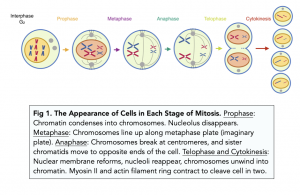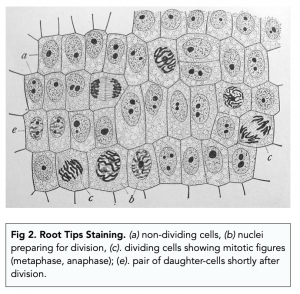Cell Division: Phases of Mitosis (A-level Biology)
Cell Division: Phases of Mitosis
Phases of Mitosis
Now that we have familiarised ourselves with chromosomes and their structure, we can move on to the steps involved in mitosis. There are five phases of mitosis and they are briefly outlined in this section.
Prophase
- Chromosomes become visible. In prophase the chromosomes condense. This is often complicated for many students. What does condense mean? Very simply, they get shorter and thicker. This makes them visible as two sister chromatids joined at the centromere.
- Centrioles split and move to opposite ends of the cell. Tiny organelles known as centrioles begin to move to opposite ends of the cell. The centrioles produce special fibres made of special protein which we call the mitotic spindle. The spindle extends across the cell.
- The nuclear envelope disintegrates. The end of prophase is marked by the breakdown of the nuclear envelope. The chromosomes are freed into the cytoplasm.
Metaphase
- At the end of prophase, we have visible chromosomes, a spindle formed, and a near broken nuclear envelope.
- The nuclear envelope is completely gone. There is no visible sign of the nuclear membrane.
- The spindle fibres attach to the chromosomes. The spindle fibres attach at the centromeres of each chromosome.
- The chromosomes line up at the equator. The spindle fibres pull the chromosomes, making them line up in the centre of the cell (at the metaphase plate).
Anaphase
At the end of metaphase, the chromosomes are lined up in the centre of the cell. They are still visible as two sister chromatids joined at the centromere.
- The chromosomes break apart at the centromere. The spindle fibres begin pulling the sister chromatids away from each other to opposite poles of the cell. This splits the chromosome into two V-shaped sister chromatid structures.
Telophase
- The chromatids reach opposite poles of the cell. The spindle fibres eventually pull the chromatids completely to opposite poles of the cell. Now, the chromatids uncoil and become long and thin again and can be called chromosomes again.
- The nuclear envelope reforms around the chromosomes. A nuclear envelope forms around each set of chromosomes – one on each pole of the cell. Therefore the cell now has two nuclei, each with a complete set of identical DNA.
- The cell prepares to split the cytoplasm and its contents. At this point, the cell will begin to form a structure called a cleavage furrow. The cleavage furrow is the point at which the cytoplasm and cell membrane will divide.
Cytokinesis
- Cytokinesis is the final step of mitosis. In this step, the cell will completely divide in to two daughter cells as the cytoplasm and cell membrane separates.
- Each daughter cell will be identical to each other and their parent cell. Each daughter will have one nucleus, a complete set of DNA, and a set of organelles and the same amount of cytoplasm as their twin sister cell.

Preparing a Root Tip Cell Squash
This practical focuses on investigating mitosis in preparations of root tip squashes using an optical light microscope. We will go over all of the steps that are required for this practical.
- Warm hydrochloric acid. Warm hydrochloric acid in a water bath at 60°C.
- Cut 1-2cm of root tip from a growing root. The tip is the active region where mitosis is occurring, so this is what we are interested in. This will be done using scalpels. The growing root tip can be from any plant such as a potato or onion.
- Wash the root tips. Wash the root tips in cold water and dry on filter paper.
- Transfer the root tip to the warm acid. Leave the root tips in the acid for around 5 minutes. The transfer needs to be done with caution.
- Remove from acid, and wash the root tips. Remove the root tips from acid, and then wash them again in cold water and dry on filter paper.
- Place the root tip on a slide. Place the root tip on a clean microscopic slide. Cut around 2mm from the end of the growing root tip 2 mm. You can discard the rest, but keep the tips.
- Stain the root tip. Add a few drops of stain to the root tips and leave for 2 minutes. The stain binds to chromosomes, enabling them to be visible under a microscope.
- Break open the root tip. Use a mounted needle to break up the tissue, and spread the cells of the root tip out onto the slide.
- Cover with a coverslip over the stained root tip. When placing the coverslip firmly, but carefully, press down on the coverslip. This will further press the root tip, making it thinner. The thinner the root tip, the more easily light will be able to pass through it, which will make it easier to observe the cells using an optical microscope.
- View the tips using a microscope. You can use a light (optical) microscope to visualise chromosomes in the tips. You should be able to see different cells in different stages of mitosis.

Follow Up Questions
Why do we use multiple root tips?
The root tips are very delicate, and can decompose. So using several increases the chances of getting good images at the end.
Why is acid used?
Plant cells tend to stick together due to their cellulose cell walls. The acid separates the cells, enabling the stain to enter more easily in step 7. The heat speeds this process up.
What does the stain bind to?
Different stains can be used, but many bind to chromatin DNA.
How would you change the method to improve your end images?
Increase time spent in HCl, increase temperature of incubation, increase time spent in stain.
FAQs
Mitosis is the process of cell division in eukaryotic cells that results in the production of two identical daughter cells.
The purpose of mitosis is to produce genetically identical daughter cells that are capable of carrying out all of the functions of the original cell. This is necessary for growth, repair, and reproduction in living organisms.
The phases of mitosis are: prophase, prometaphase, metaphase, anaphase, telophase, and cytokinesis.
In prophase, the chromatin condenses into discrete structures called chromosomes, which become visible under a microscope. The spindle apparatus, which is made up of microtubules and centrosomes, also begins to form.
In prometaphase, the nuclear envelope breaks down and the spindle fibers attach to the chromosomes at their kinetochores. The chromosomes are now ready to be pulled apart during the next phase of mitosis.
In metaphase, the chromosomes line up along the center of the cell, called the equatorial plane, in a way that ensures that each daughter cell will receive an exact copy of the genetic material.
In anaphase, the spindle fibers begin to pull the chromosomes apart, separating the sister chromatids and distributing them to opposite poles of the cell.
In telophase, a new nuclear envelope forms around each set of chromosomes and the chromosomes begin to decondense into chromatin.
In cytokinesis, the cytoplasm divides, separating the two daughter cells and completing the process of cell division.
Mitosis ensures that each daughter cell receives the correct number of chromosomes by carefully controlling the distribution of the chromosomes during cell division. The spindle apparatus, along with various other cellular structures and processes, work together to ensure that each daughter cell receives an exact copy of the genetic material.






Still got a question? Leave a comment
Leave a comment